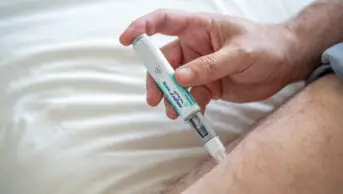
Shutterstock.com
After reading this article, you should be able to:
- Recall the HbA1c limit for elective surgery and the reason for this limit;
- Know where to find guidance on the perioperative management of medications for type 2 diabetes mellitus;
- Understand the situations in which continuous intravenous insulin infusions are necessary.
Hyperglycaemia can develop in surgical patients owing to hypermetabolic stress response, which increases glucose production and causes insulin resistance. People with diabetes are at higher risk of developing hyperglycaemia and this is associated with post-operative complications, such as acute kidney injury, acute myocardial infarction and death[1–3].
Poor glycaemic control can also lead to increased risk of post-operative infection and delayed wound healing[1,3,4]. Conversely, hypoglycaemia is associated with an increased length of stay and excess mortality[4]. For patients with diabetes mellitus undergoing elective surgery, it is important to maintain capillary blood glucose between 6 and 12 mmol/L[5].
Ideally, patients with diabetes should have a HbA1c blood test within three months of planned elective surgery to identify those who have suboptimal pre-operative glycaemic control and would benefit from optimisation[5]. The current recommendation in the UK is that HbA1c should be <69 mmol/mol to safely proceed with elective surgery[5]. If HbA1c is above this level, ideally surgery should be delayed allowing for optimisation of glycaemic control since higher HbA1c is associated with adverse post-operative outcomes, including increased six-month mortality and increased hospital length of stay[6]. However, where surgery is urgent and cannot be delayed (e.g. cancer surgery), variable-rate intravenous insulin infusion (VRIII) may be needed for intraoperative glycaemic control (see below), and a referral to the diabetes specialist team is advised to support inpatient glycaemic control and post-operative medication review[5].
People with diabetes undergoing inpatient surgery are at a higher risk of medication errors and this is associated with adverse post-operative outcomes[5,7]. One factor in this is lack of knowledge about diabetic medication, so it is important that healthcare workers involved in the care of diabetic patients have appropriate training on these medicines[5].
Patients with diabetes undergoing surgery should have an individualised care plan developed by an appropriate healthcare professional (i.e. pre-operative assessment team or diabetes specialist team) in conjunction with the patient; it should include instructions on the necessary changes to their medication prior to admission[5].
Management of non-insulin diabetic medication in the perioperative period
Non-insulin diabetic medication can be classified into two groups: those that can cause hypoglycaemia and those that do not (see Table 1[5,8]). Medication that can cause hypoglycaemia, such as sulfonylureas, should always be omitted during the fasting period. Medicines that do not cause hypoglycaemia, such as dipeptidyl peptidase-IV inhibitors, can usually be safely continued prior to and on the day of surgery[5,8]. However, sodium-glucose co-transporter-2 (SGLT-2) inhibitors and metformin, while not associated with hypoglycaemia, may be held for other reasons. Table 1 lists the instructions regarding non-insulin diabetic medication when a patient is due for surgery.
Metformin
Metformin is contraindicated in patients with severe renal impairment owing to concerns that accumulation will result in lactic acidosis, which can be fatal. Other risk factors for developing lactic acidosis include dehydration and prolonged fasting[8]. Consequently, manufacturers advise that metformin should be discontinued for all patients at the time of surgery under general, spinal or epidural anaesthesia, and restarted no earlier than 48 hours after, on resumption of oral nutrition and where renal function has been checked and is stable[8]. This recommendation also extends to patients receiving iodinated contrast agents because of the potential for contrast-induced nephropathy[8].
The manufacturer’s recommendation to stop metformin for all patients before surgery is in stark contrast to the Centre for Perioperative Care’s guidelines, which recommend continuing metformin preoperatively in most patients[5]. This divergence is a legacy of earlier biguanides, which were withdrawn from the market because of a high incidence of lactic acidosis. Metformin differs from these earlier biguanides in both molecular structure and pharmacokinetics[9]. Metformin-associated lactic acidosis is extremely rare, with an estimated incidence of 0.03 to 0.06 cases per 1,000 patient years and mainly occurs in patients with pre-disposing conditions or intercurrent precipitating events that predispose to lactic acidosis[10]. A Cochrane review found no evidence from prospective comparative trials or observational cohort studies that metformin is associated with increased risk of lactic acidosis, or with increased levels of lactate, compared with other treatments, providing there is no renal impairment or other contraindications to its use[9].
Furthermore, meta-analysis has shown that metformin use in the 180 days before surgery lowers mortality in surgical patients with diabetes. This may reflect the established long-term protective effect of metformin on mortality, but it has also been hypothesised that metformin’s pleiotropic and anti-inflammatory effects result in acute perioperative organ protection[11].
SGLT-2 inhibitors
SGLT-2 inhibitors have been associated with serious, life-threatening and fatal cases of diabetic ketoacidosis[12,13]. Risk factors for patients undergoing surgery are restricted food and fluid intake (i.e. perioperative fasting), use of bowel preparation and severe volume depletion (i.e. from fluid or blood loss). Hence, it is currently advised to omit SGLT-2 inhibitors the day before and the day of surgery[5]. Blood ketone levels should be monitored and SGLT-2 inhibitor treatment only recommenced once the patient’s condition is stable post-operatively, ketones are within range and normal oral intake is established[1,5,12,13]. The management of SGLT-2 inhibitors continues to cause some debate, with other international publications suggesting a longer period of omission prior to surgery (Australian Diabetes Society[14], European Society of Cardiology[15] and American College of Cardiology[16]), while there has also been a call to re-examine the current practice of stopping them routinely for all patients on admission to hospital[5]. However, until further data are available, the current recommendation by the UK-based Centre for Perioperative Care remains in place[5].
GLP-1 analogues
Questions have been raised about the link between glucagon-like peptide-1 (GLP-1) analogues and aspiration of gastric contents. Although the US Food and Drug Administration has recommended these medications be stopped preoperatively, the evidence base for this decision is minimal, and the Centre for Perioperative Care has reconfirmed its stance that GLP-1 analogues should be continued preoperatively[5,17].
Management of insulin in the perioperative period
Hypoglycaemia is an adverse effect of insulin therapy and so appropriate pre-operative management is imperative. Insulin therapy is used for both type 1 and type 2 diabetes mellitus. It is classed as a ‘high-risk’ medication because of the variety of products available and complex pharmacology of different preparations[7,18]. The pharmacist should ask the patient to confirm the exact name, strength, dose, frequency, and preparation of insulin that they are using[8].
Pre-operative advice on insulin management should be based on knowledge of the different products available and how different types of insulin work[1]. Table 2 shows the management of long-acting insulins in patients undergoing surgery and Table 3 shows the management of pre-mixed insulins in patients undergoing surgery[5,8].
When reducing insulin doses, it is necessary to round to the nearest unit for practical reasons. For example, for a patient on 16 units, 80% of the dose is 12.8 units and this would be rounded to 13 units.
Variable-rate intravenous insulin infusion
Variable-rate intravenous insulin infusion (VRIII) is the preferred option for managing serum glucose in patients with diabetes mellitus undergoing surgery in the following circumstances[5]:
- Patients with type 1 or 2 diabetes mellitus who are expected to miss more than one meal;
- Patients with type 1 diabetes mellitus who have not received their basal insulin;
- Patients with suboptimal diabetes management (HbA1c >69 mmol/mol [> 8.5%]);
- Patients with capillary blood glucose levels that are persistently greater than 12 mmol/L.
The aim of VRIII is to achieve and maintain glucose levels within the range 6–10 mmol/L[5].
GLP-1 analogues can be continued with VRIII treatment as they pose no risk of hypoglycaemia. This is particularly preferable for GLP-1 analogue preparations that are administered on a weekly basis, since there are specific instructions for administration of the dose if it has been missed on the usual day.
Long-acting insulin should be continued throughout VRIII treatment at 80% of the patient’s usual dose[5,8]. Continuation of long-acting insulin helps to control blood glucose during VRIII use and helps to avoid rebound hyperglycaemia on cessation[5].
Non-elective (emergency) surgery
The general principles around the management of diabetic medication perioperatively can be applied to patients presenting for emergency surgery if there is sufficient time to follow the advice, although management with VRIII may be preferred[5,8].
Conclusion
Good glycaemic control should be encouraged at all stages of the patient’s surgical pathway. It is associated with improved outcomes following surgery; therefore, where possible HbA1c should be <69 mmol/mol before elective surgery. When deciding whether to stop diabetic medications before surgery, it is necessary to consider the risk of hypoglycaemia and other complications, such as euglycaemic diabetic ketoacidosis. Up-to-date guidance on the perioperative management of diabetic medications can be found in the UKCPA Handbook of Perioperative Medicines and the Centre for Perioperative Care.
- 1Peri-operative Care. Inpatient Diabetes Training and Support. Inpatient Diabetes Training and Support. 2019. www.inpatientdiabetes.org.uk (accessed March 2024)
- 2Jones KW, Cain AS, Mitchell JH, et al. Hyperglycemia predicts mortality after CABG: postoperative hyperglycemia predicts dramatic increases in mortality after coronary artery bypass graft surgery. Journal of Diabetes and its Complications. 2008;22:365–70. https://doi.org/10.1016/j.jdiacomp.2007.05.006
- 3Yeh C-C, Liao C-C, Chang Y-C, et al. Adverse Outcomes After Noncardiac Surgery in Patients With Diabetes. Diabetes Care. 2013;36:3216–21. https://doi.org/10.2337/dc13-0770
- 4Levy N, Penfold NW, Dhatariya K. Perioperative management of the patient with diabetes requiring emergency surgery. BJA Education. 2017;17:129–36. https://doi.org/10.1093/bjaed/mkw056
- 5Guideline for Perioperative Care for People with Diabetes Mellitus Undergoing Elective and Emergency Surgery. Centre for Perioperative Care. 2023. https://cpoc.org.uk/guidelines-resources/guidelines (accessed March 2024)
- 6Yong PH, Weinberg L, Torkamani N, et al. The Presence of Diabetes and Higher HbA1c Are Independently Associated With Adverse Outcomes After Surgery. Diabetes Care. 2018;41:1172–9. https://doi.org/10.2337/dc17-2304
- 7National Diabetes Inpatient Audit (NaDIA) . NHS England. 2019. https://digital.nhs.uk/data-and-information/publications/statistical/national-diabetes-inpatient-audit/2019 (accessed March 2024)
- 8The Handbook of Perioperative Medicines. UK Clinical Pharmacy Association. 2024. www.periop-handbook.ukclinicalpharmacy.org (accessed March 2024)
- 9Salpeter SR, Greyber E, Pasternak GA, et al. Risk of fatal and nonfatal lactic acidosis with metformin use in type 2 diabetes mellitus. Cochrane Database of Systematic Reviews. 2010. https://doi.org/10.1002/14651858.cd002967.pub3
- 10DeFronzo R, Fleming GA, Chen K, et al. Metformin-associated lactic acidosis: Current perspectives on causes and risk. Metabolism. 2016;65:20–9. https://doi.org/10.1016/j.metabol.2015.10.014
- 11Jones TF, Iakovou D, Makariou N, et al. Metformin and mortality after surgery: a systematic review and meta-analysis. British Journal of Anaesthesia. 2022;128:e277–9. https://doi.org/10.1016/j.bja.2022.01.001
- 12SGLT2 inhibitors: updated advice on the risk of diabetic ketoacidosis. Medicines and Healthcare Products Regulatory Agency . 2016. https://www.gov.uk/drug-safety-update/sglt2-inhibitors-updated-advice-on-the-risk-of-diabetic-ketoacidosis (accessed March 2024)
- 13EMA confirms recommendations to minimise ketoacidosis risk with SGLT-2 inhibitors for diabetes. European Medicines Agency. 2016. https://www.ema.europa.eu/en/medicines/human/referrals/sglt2-inhibitors (accessed March 2024)
- 14Alert Update January 2020: Periprocedural Diabetic Ketoacidosis (DKA) with SGLT2 Inhibitor Use. Australian Diabetes Society, New Zealand Society for the Study of Diabetes. 2020. https://www.diabetessociety.com.au/documents/ADS_DKA_SGLT2i_Alert_update_2020.pdf (accessed March 2024)
- 15Halvorsen S, Mehilli J, Cassese S, et al. 2022 ESC Guidelines on cardiovascular assessment and management of patients undergoing non-cardiac surgery. European Heart Journal. 2022;43:3826–924. https://doi.org/10.1093/eurheartj/ehac270
- 16Kumar S, Bhavnani S, Goyal P, et al. Preoperative Cessation of SGLT2i. American College of Cardiology. 2022. https://www.acc.org/Latest-in-Cardiology/Articles/2022/10/07/17/21/Preoperative-Cessation-of-SGLT2i#:~:text=When%20caring%20for%20patients%20being,ketoacidosis%20and%20urinary%20tract%20infections (accessed March 2024)
- 17Dhatariya K, Levy N, Russon K, et al. Perioperative use of glucagon-like peptide-1 receptor agonists and sodium-glucose cotransporter 2 inhibitors for diabetes mellitus. British Journal of Anaesthesia. 2024. https://doi.org/10.1016/j.bja.2023.12.015
- 18Medication Safety in High-Risk Situations. World Health Organization. 2019. https://apps.who.int/iris/handle/10665/325131 (accessed March 2024)


